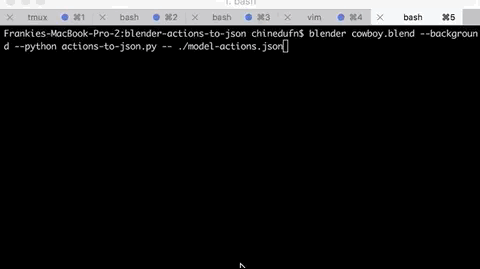blender-actions-to-json 

Given a Blender
.blendfile, write the joint data for all actions to a JSON file

Initial Background / Motivation
Before
I export my Blender models to COLLADA using the native Blender COLLADA exporter before parsing these COLLADA files for my model's data.
Unfortunately this only includes the raw keyframes and no metadata about which keyframes belong to which action, so I end up needing to manually keep track of which keyframe each action starts on.
After
The purpose of this module is to remove that work for me. Now if I want to get the keyframes and joints for the attack animation, I can just
reference the JSON action file that this module generates under the key attack.
If the number of keyframes for the attack action changes, they'll still all be under the attack action key in the JSON data so
I will still have access to them without needing to manually specify the new range of keyframes. Just iterate over the attack key
This is part of an effort to automate more of my asset pipeline.
To Install
We currently support Blender version 2.80 and up
npm install -g blender-actions-to-json# This will save the actions2json command to your Blender User Preferences # so that you can call it from within Blender. actions2json --installUsage
# Run via CLI
blender /path/to/my-model.blend --background --python `actions2json` -- /path/to/output.json
# Run via bpy.ops
bpy.ops.import_export.actions2json(filepath='/path/to/output.json')
The outputted file will look something like this:
The file has all of your actions. Each action has all of the keyframe times for that action. Each keyframe time has the pose matrices for each joint in your armature.
The ordering of the joints is the same as bpy.context.selected_pose_bones.
~InverseBindPoses~ The inverse bind matrix is the matrix that when multiplied by your joint’s default position moves your joint to the origin, in model space. The inverse bind matrix ensures that when you parent your mesh to your rig your vertices won't move (because all of your bones get turned into identity matrices before transforming your vertices) until you move your rig out of this bind position.
If any of this is confusing please open an issue!
CLI Usage
actions2json --help Usage $ actions2json # Returns the filename of the Blender addon. Useful for running the addon via CLI # i.e. # blender my-model.blend --python \`actions2json\` -- /var/tmp/output-file.json $ actions2json --help # Prints some help text on how to use this command $ actions2json --install # Installs and enables the addon and then saves it to your Blender user preferences # Note that you must have Blender in your $PATH in order for this command to work Options -h, --help -> Get help text about using the blender-actions-to-json CLI -i, --install -> Install the addon and save it in your Blender Note
blender-actions-to-json currently only exports actions for one armature.
This script currenly requires that your bpy.context.active_object is your armature.
blender-actions-to-json will use the first armature that it finds if the bpy.context.active_object is not an armature,
so if your file only has one armature you're good to go.
Otherwise you will need either need to select your desired armature before running this script.
You can do this by either:
- Running an armature selection script before this script
- OR manually right click it while in object mode before running this script.
If you're looking to use this script as part of a fully automated pipeline, #2 is not an option and you will need to do #1.
You can chain blender scripts, so you can run blender my-model.blend --background --python my-script-that-selects-armature --python blender-actions-to-json.py -- ./outputfile.json
Again, all of this only applies if your Blender file has more than one armature. When I eventually work with files with multiple armatures I'll have a better idea of how to address this.
If any of this is confusing please open an issue and I'll try to give a better explanation based on your question(s)!
To test
In order to run the tests you'll need to have blender in your $PATH so that we can spawn a headless blender process from Node.js.
If Blender isn't already in your $PATH, on mac you can try export PATH="$PATH:/Applications/blender.app/Contents/MacOS" in your terminal
git clone https://github.com/chinedufn/blender-actions-to-jsoncd blender-actions-to-jsonnpm installnpm run testTODO:
- Maybe support a
-p, --precisionflag to specify the number of decimal places that pose matrices are rounded to
See Also
License
MIT